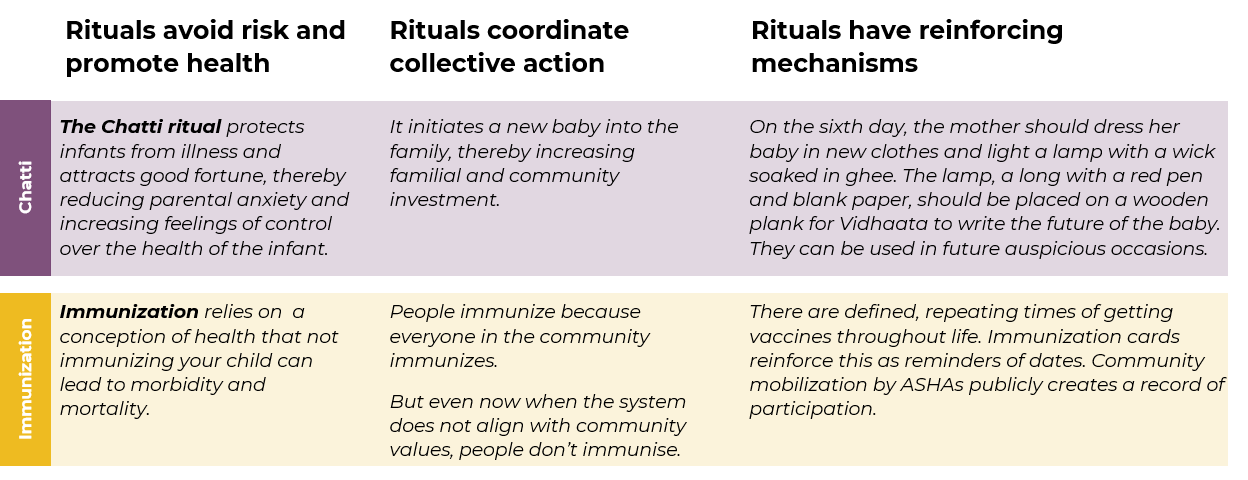0.10 A Ritual Lens and Project RISE
Project RISE uses a ritual lens to achieve several inter-related outcomes. One direct outcome is a rich and complete description of the rituals, behaviors, beliefs, and practices that exemplify the perinatal experience in Bihar. The ritual lens helps achieve a deeper and more meaningful understanding of the factors that affect behavior because it includes the behavior, the stated reason for it, and a source of influence. Additionally, we benefit from the perspectives gained by trying to document and understand the form and function of ritual. The objective focused on ritual content is presented in Chapter 11 and the additional consequences of this perspective are discussed in Chapter 12.
Figure 0.4 gives an example of two rituals and their associated content, roles in fostering collective action, and their reinforcing mechanisms.

Figure 0.4: Key ritual elements for the examples of Chhathi and immunization.
Rituals, beliefs, practices, habits, and behaviors are all examples of complex cultural phenomena that do not exist in isolation (hence our emphasis on connectedness). A ritual awareness examines these things for how they connect so that solutions may come in the form of tweaks or the potential of changing a seemingly non-health-related ritual because of its influence on another. Ritual leveraging is more direct in that it modifies or directly applies a ritual to health behaviors of interest. Applying such distinctions to certain behaviors or contexts can only be done after extensive analysis and synthesis.
In understanding the role of ritual in shaping behaviors or beliefs, one must document the following:
the function or functions of the rituals and behaviors
influencers, those who inform the woman about the behavior and especially those who affect the probability that she actually does or doesn’t do it
obstacles that may stem from other behaviors/practices that are connected or adjacent to the ritual, or perhaps a physical distancing that occurs due to the ritual that makes messaging difficult
how the practice is transmitted, meaning identifying if it is learned from parents/neighbors, if it is sacred/religious, or derived from some other source
By studying dozens of biomedical and traditional behaviours, project RISE identified four connected and overlapping factors that can be used to map the complex cultural ecology surrounding these behaviours and also identify strategies to facilitate behaviour change. These are: motivations, behaviours, access, and influencers. Motivations refers to the reasons behind doing or not doing a behavior and for influencers supporting, blocking, or gatekeeping a behaviour. The factor ‘behaviors’ refers to the degree to which a particular behaviour is connected to norms and associated beliefs that might prevent a particular behaviour from changing. Access refers to health systems access to the beneficiary through the CHWs or through other actors of the health system, which might be hindered due to cultural norms and practices. Influencers refers to a host of actors in the interpersonal and social lives of the pregnant woman, that have a significant influence on perpetuating a behaviour or hindering the uptake of a new one.
0.10.1 Replacement, Conflict, and Complementarity
Early on in Project RISE we found that belief systems can various kinds of relationships, depending on how they interact. We generalize these to replacement, conflict and complementary coexistence (see especially Chapter 3 for more information on basis and discussion of these concepts). In replacement, a new belief or practice supplants and replaces a previously existing one. Conflict occurs when two beliefs or practices when there is tension or direct friction between a new and an existing practice. Complementary coexistence occurs when the new and existing practice continue to co-exist, perhaps with modest modifications, and may even reinforce one another. For behavioral change messaging and strategizing, conflicts can create barriers or blocks to the goal of altering a behavioral target, whereas complementarity can ensure more rapid uptake and blending of rituals or beliefs.
0.10.2 Most Rituals are Motivated by health promotion or risk aversion
Project RISE documented many rituals and beliefs associated with the perinatal journey in Bihar and found that the majority were motivated to promote health or avoid risk (Chapter 3. This motivation is exactly in line with motives of the biomedical behaviors and rituals that many organizations are trying to increase the frequency of. It is important to recognize this commonality in purpose before mislabeling a traditional practice as detrimental when it isn’t completely necessary. Likewise, in terms of actual outcomes of the behaviors, only a very small percentage seem to contradict prevailing biomedical advice. Those that do, are largely concentrated in the first few days postpartum.